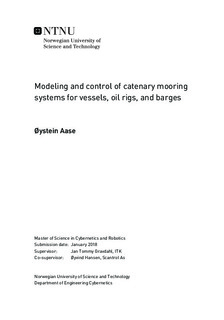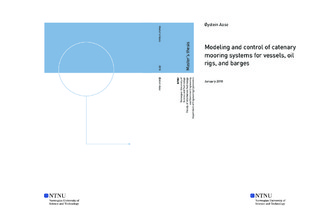| dc.description.abstract | In this master thesis, an automatic positioning system for moored vessels has been studied. Although there exist dynamic positioning systems for vessels with integrated thrusters, this system will be considering operations where access to these is limited, usually due to shallow waters. Using the mooring system combined with winches onboard, it is possible to distribute forces such that the vessel moves in the desired direction within the limits of the anchor points. In cooperation with Scantrol As we will propose a control system that can be integrated with existing winch control systems. The performance will then be evaluated through realistic simulations of a vessel in operation.
To be able to test the algorithm, a simulator has been developed in Matlab/Simulink. This simulator is divided into four parts, namely guidance, MPC, winch models, and the vessel model. The guidance handles the switching of waypoints when the waypoint tracking mode is switched on. The MPC optimally distributes forces to all winches onboard such that the reference NED coordinate is being tracked. These desired forces are then being converted into angles that the mathematical models of the winches can use as for a reference input. Finally, the resultant forces and moments produced by the winches are being applied to the vessel model. Due to the various vessels types that may be interested in such a system, an adaptive ship model has been developed based on a 3DOF DP-model.
It is important for an operator to be able to measure the states of the mooring lines due to safety reasons. A dynamic mooring model has therefore been implemented so that the operator can easily analyze the behavior of the lines. The model takes tension produced by the winches as input and simulates the behavior when exposed to hydrodynamic effects and tension change. Due to the high complexity, the mooring model will only serve as additional visual functionality for the operator. Many considerations have been taken to ensure safety. The MPC has constraints on tension which handles the possibility of a line breaking. There is also implemented an alarm system that notifies the operator when the vessel exceeds the limits of the anchor points. When this is happening, the operator needs to rearrange the anchor points to continue operation.
The results of this study indicate that the complete system has the desired behavior, in the sense that the vessel can track waypoints specified by the user within certain error limits, even when exposed to environmental disturbances. There are several advantages in using an MPC over the conventional PID controller proposed in the previous work on this system. It is possible to set constraints on the objective function to ensure safety. Another advantage is that the vessel model and the control allocation algorithm can be combined and implemented into the MPC. The predictive ability does also come in handy when optimal decisions need to be executed. | |

